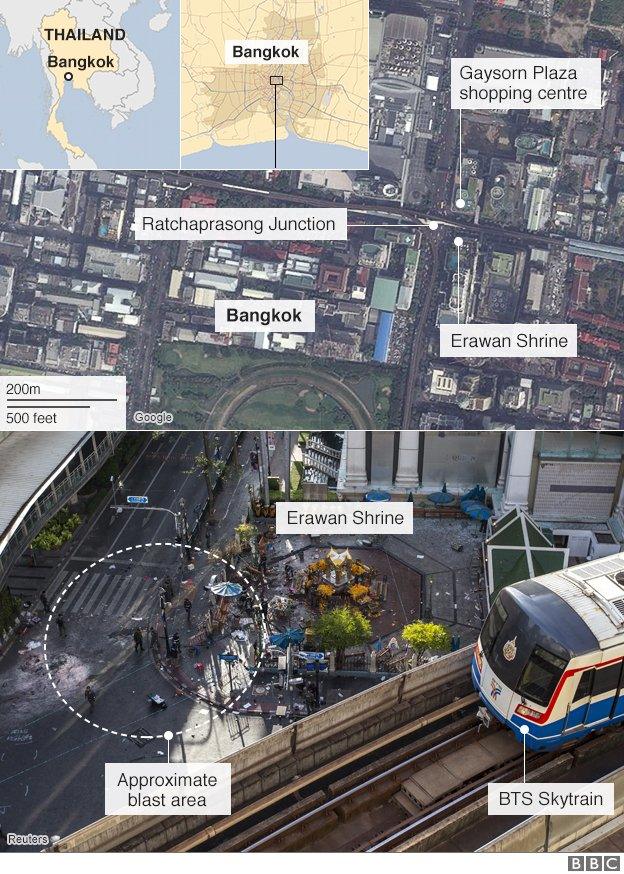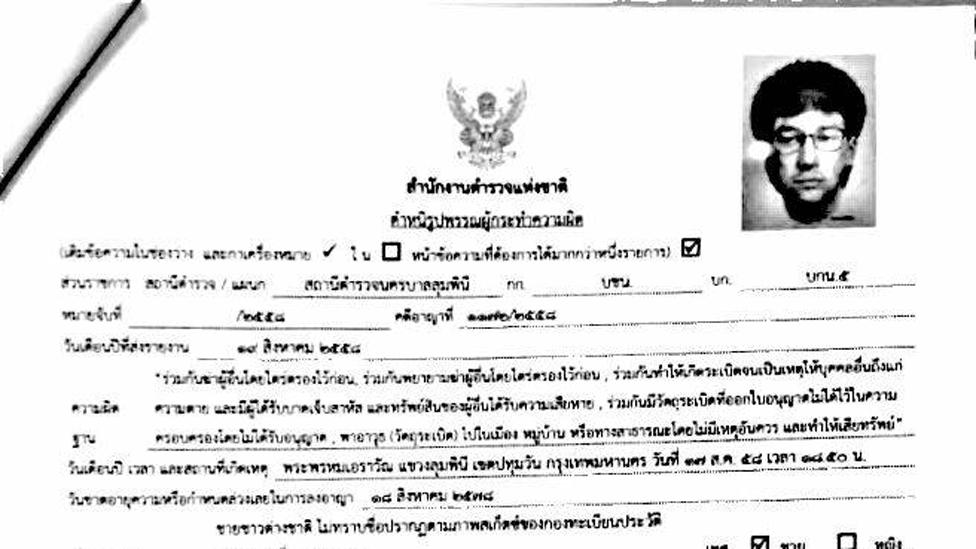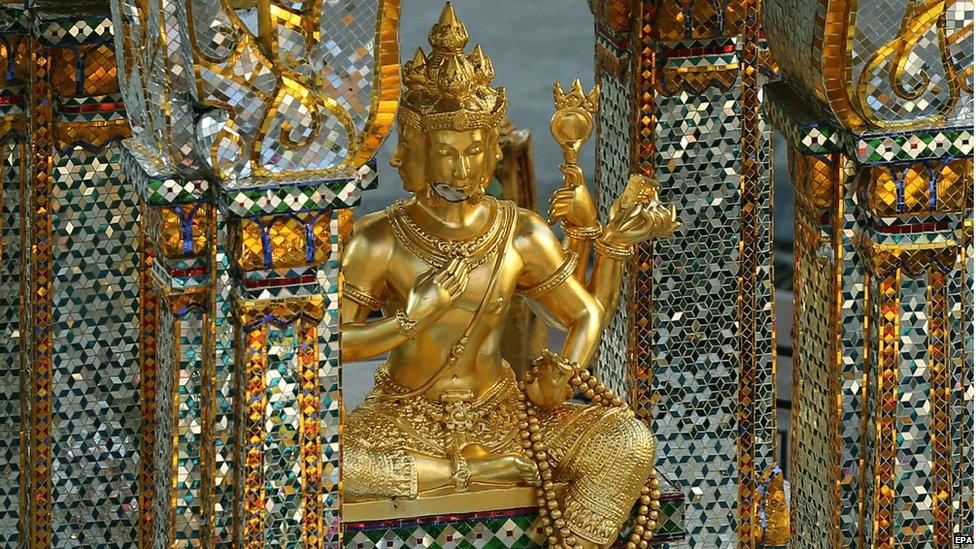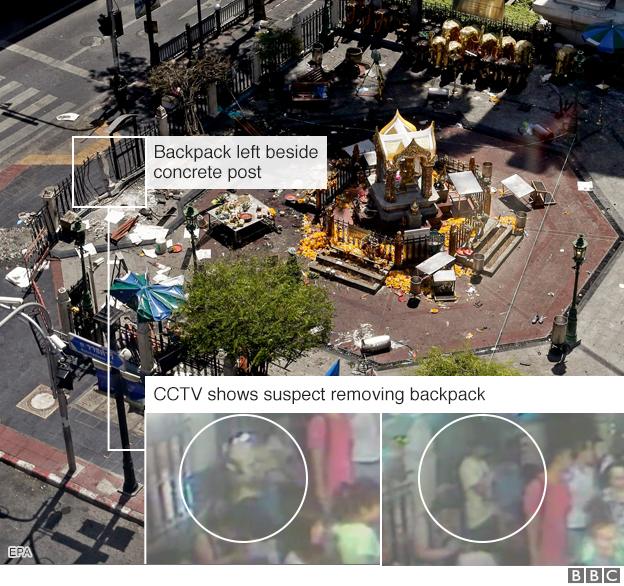Bangkok bomb: Erawan shrine attacker 'is part of network', police say
- Published
Police spokesman Prawut Thavornsiri says it is possible the main suspect was wearing a disguise
The bomb attack that killed 20 people at Bangkok's Erawan shrine on Monday was carried out by a "network", Thailand's chief of police has said.
Police have released a sketch of the main suspect, a man in a yellow T-shirt who was filmed by security cameras leaving a backpack at the shrine.
Police later said two other people seen on CCTV were being treated as suspects.
Prime Minister Prayuth Chan-ocha has described the incident as the worst-ever attack on Thailand.
The Hindu shrine, popular with tourists and Buddhists, reopened on Wednesday.
'Hired to plant bomb'

Police chief Somyot Poompanmoung told the Associated Press news agency that the shrine attack was the work of more than one person.
"He didn't do it alone for sure," he said, referring to the main suspect. "It's a network," he added, without giving further information. But he said he was certain that Thai citizens were involved in the bombing.
Although the main suspect in the footage has not been identified, an arrest warrant for him has been issued by Bangkok's Southern Criminal Court. It accuses an "unnamed foreigner" of conspiracy to commit "premeditated murder" and weapons offences.
Police spokesman Prawut Thawornsiri said in a TV interview that the man could be of "mixed origin".

Bangkok bomb attack
People have been visiting the Erawan shrine to pray, as Stephen Evans reports
'A tremendous role model': The people killed in Bangkok
In pictures: Worshippers return to the shrine
The facts: What we know so far
Who did it? The theories behind the Thai attack
Tourism hit: Will travellers avoid Bangkok?

A reward of one million baht ($28,000; £17,950) has been offered for information leading to his arrest.
Mr Prawut also said that two other men seen in the grainy CCTV footage were being sought. "The person in red and the person in white are also suspects," he said.
The BBC's Steve Evans in Bangkok says the new information implies this may have been an organised international operation, perhaps with a religious motive.
The prime minister urged the main suspect to surrender to the police because he might otherwise "get killed to stop him from talking".
Mr Prayuth told reporters the man must have been hired to plant the bomb.
However, our correspondent says there are indications the main suspect was driven to the airport after the attack and may well have flown.

An arrest warrant has been issued for an "unnamed foreigner"

The statue of the Hindu god Brahma was slightly damaged in Monday's attack
The shrine reopened at about 08:00 local time (01:00 GMT), with a handful of people arriving to place flowers or light incense in front of the slightly damaged statue of the Hindu god Brahma.
A BBC reporter at the scene says there appears to be low security in place, with the public free to walk in unchecked. She says the last human remains were only cleared from the site earlier on Wednesday.
Most of the victims of Monday's attack were Thai, but nationals from China, Hong Kong, the UK, Indonesia, Malaysia and Singapore were among the foreigners killed.
No-one has yet said they carried out the attack.
The two men were captured on CCTV standing near the main suspect, in yellow
In a separate attack on Tuesday, an explosive device was thrown at a pier in Bangkok. No-one was hurt, but the authorities have not ruled out a link between the incidents.
Maj Gen Weerachoon Sukhontapatipak, a spokesman in the military government, earlier told the BBC that the authorities were "quite close" to identifying the suspect caught on CCTV at the shrine.
The man is seen carefully removing his backpack inside the shrine - at the spot the bomb went off - then getting up without it and immediately leaving.
Gen Sukhontapatipak said no motive was being ruled out and the character of the bombing was "quite different" from previous attacks by Islamist separatists in southern Thailand.
Speaking in a television address on Tuesday evening, Mr Prayuth said the attack showed that Thailand "still has a person or a group of people with hostility to the nation operating actively".
"They may be doing it for a political motive or to undermine the economy or tourism or for other reasons," he said, according to the Bangkok Post.
He also warned against speculation on possible perpetrators, saying it could cause panic or mislead the investigation.

Bangkok explosion
